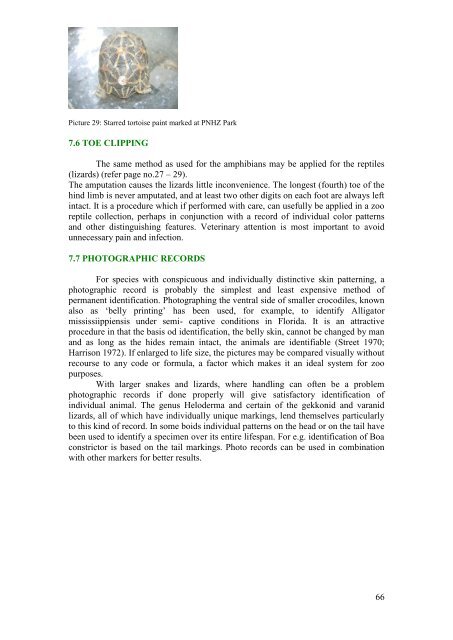standardization of records keeping in indian zoos - Central Zoo ...
standardization of records keeping in indian zoos - Central Zoo ...
standardization of records keeping in indian zoos - Central Zoo ...
You also want an ePaper? Increase the reach of your titles
YUMPU automatically turns print PDFs into web optimized ePapers that Google loves.
Picture 29: Starred tortoise pa<strong>in</strong>t marked at PNHZ Park<br />
7.6 TOE CLIPPING<br />
The same method as used for the amphibians may be applied for the reptiles<br />
(lizards) (refer page no.27 – 29).<br />
The amputation causes the lizards little <strong>in</strong>convenience. The longest (fourth) toe <strong>of</strong> the<br />
h<strong>in</strong>d limb is never amputated, and at least two other digits on each foot are always left<br />
<strong>in</strong>tact. It is a procedure which if performed with care, can usefully be applied <strong>in</strong> a zoo<br />
reptile collection, perhaps <strong>in</strong> conjunction with a record <strong>of</strong> <strong>in</strong>dividual color patterns<br />
and other dist<strong>in</strong>guish<strong>in</strong>g features. Veter<strong>in</strong>ary attention is most important to avoid<br />
unnecessary pa<strong>in</strong> and <strong>in</strong>fection.<br />
7.7 PHOTOGRAPHIC RECORDS<br />
For species with conspicuous and <strong>in</strong>dividually dist<strong>in</strong>ctive sk<strong>in</strong> pattern<strong>in</strong>g, a<br />
photographic record is probably the simplest and least expensive method <strong>of</strong><br />
permanent identification. Photograph<strong>in</strong>g the ventral side <strong>of</strong> smaller crocodiles, known<br />
also as „belly pr<strong>in</strong>t<strong>in</strong>g‟ has been used, for example, to identify Alligator<br />
mississiippiensis under semi- captive conditions <strong>in</strong> Florida. It is an attractive<br />
procedure <strong>in</strong> that the basis od identification, the belly sk<strong>in</strong>, cannot be changed by man<br />
and as long as the hides rema<strong>in</strong> <strong>in</strong>tact, the animals are identifiable (Street 1970;<br />
Harrison 1972). If enlarged to life size, the pictures may be compared visually without<br />
recourse to any code or formula, a factor which makes it an ideal system for zoo<br />
purposes.<br />
With larger snakes and lizards, where handl<strong>in</strong>g can <strong>of</strong>ten be a problem<br />
photographic <strong>records</strong> if done properly will give satisfactory identification <strong>of</strong><br />
<strong>in</strong>dividual animal. The genus Heloderma and certa<strong>in</strong> <strong>of</strong> the gekkonid and varanid<br />
lizards, all <strong>of</strong> which have <strong>in</strong>dividually unique mark<strong>in</strong>gs, lend themselves particularly<br />
to this k<strong>in</strong>d <strong>of</strong> record. In some boids <strong>in</strong>dividual patterns on the head or on the tail have<br />
been used to identify a specimen over its entire lifespan. For e.g. identification <strong>of</strong> Boa<br />
constrictor is based on the tail mark<strong>in</strong>gs. Photo <strong>records</strong> can be used <strong>in</strong> comb<strong>in</strong>ation<br />
with other markers for better results.<br />
66
















